Hyundai Bayon vs Abarth 600 – Differences & prices compared
Compare performance, boot space, consumption and price in one view.
Find out now: which car is the better choice for you – Hyundai Bayon or Abarth 600?
The Hyundai Bayon (SUV) comes with a Petrol engine and Manuel or Automatic transmission. In comparison, the Abarth 600 (Hatchback) features a Electric engine with Automatic transmission.
When it comes to boot capacity, the Hyundai Bayon offers 411 L, while the Abarth 600 provides 360 L – depending on how much space you need. If you’re looking for more power, decide whether the 100 HP of the Hyundai Bayon or the 280 HP of the Abarth 600 suits your needs better.
In terms of consumption, the values are 5.40 L per 100 km for the Hyundai Bayon, and 17.50 kWh for the Abarth 600.
Price-wise, the Hyundai Bayon starts at 20100 £, while the Abarth 600 is available from 38600 £. Compare all the details and find out which model fits your lifestyle best!
Hyundai Bayon
The Hyundai Bayon is a compact crossover that effortlessly merges practicality with modern design. Its sleek exterior and spacious interior make it an ideal choice for urban settings and longer journeys alike. With a focus on comfort and connectivity, this vehicle provides a smooth driving experience paired with advanced technology features.
details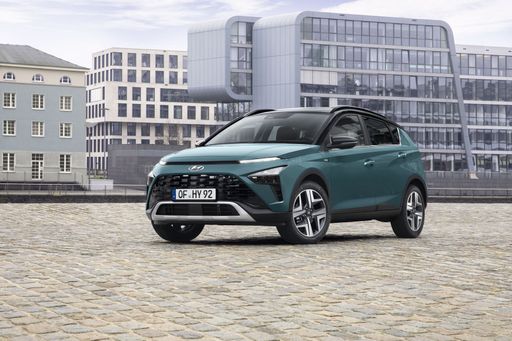 @ hyundai.news
@ hyundai.news
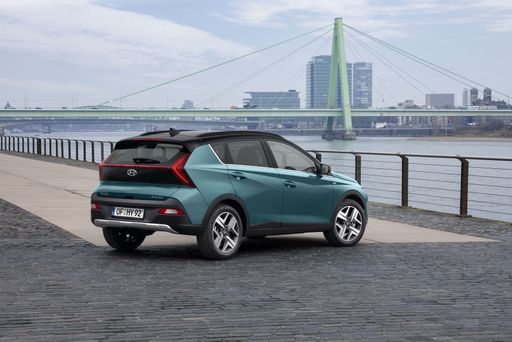 @ hyundai.news
@ hyundai.news
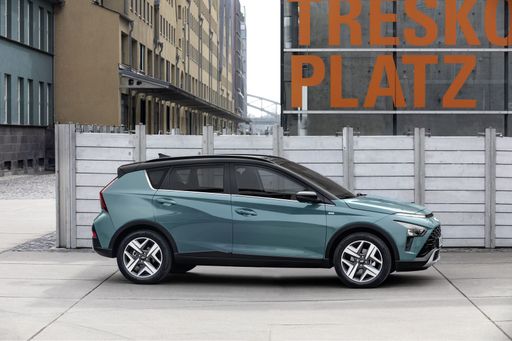 @ hyundai.news
@ hyundai.news
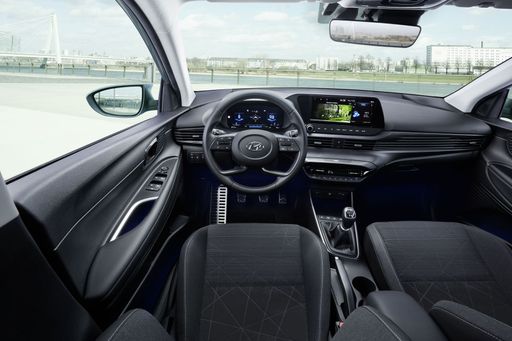 @ hyundai.news
@ hyundai.news
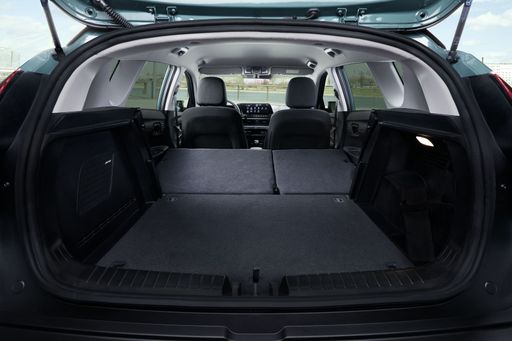 @ hyundai.news
@ hyundai.news
Abarth 600
The sleek and stylish 600 has captured the hearts of both casual drivers and automotive enthusiasts alike. With its retro charm and modern features, this model seamlessly blends classic design with contemporary performance. Whether navigating city streets or embarking on a weekend adventure, the 600 offers a driving experience that is both fun and memorable.
details

|
|
|
|
|
Costs and Consumption |
|
|---|---|
|
Price
20100 - 25800 £
|
Price
38600 - 42000 £
|
|
Consumption L/100km
5.4 - 5.5 L
|
Consumption L/100km
-
|
|
Consumption kWh/100km
-
|
Consumption kWh/100km
17.50 kWh
|
|
Electric Range
-
|
Electric Range
344 km
|
|
Battery Capacity
-
|
Battery Capacity
51 kWh
|
|
co2
124 g/km
|
co2
0 g/km
|
|
Fuel tank capacity
40 L
|
Fuel tank capacity
-
|
Dimensions and Body |
|
|---|---|
|
Body Type
SUV
|
Body Type
Hatchback
|
|
Seats
5
|
Seats
5
|
|
Doors
5
|
Doors
5
|
|
Curb weight
1170 - 1195 kg
|
Curb weight
1700 kg
|
|
Trunk capacity
411 L
|
Trunk capacity
360 L
|
|
Length
4180 mm
|
Length
4187 mm
|
|
Width
1775 mm
|
Width
1779 mm
|
|
Height
1500 mm
|
Height
1557 mm
|
|
Payload
460 - 465 kg
|
Payload
225 kg
|
Engine and Performance |
|
|---|---|
|
Engine Type
Petrol
|
Engine Type
Electric
|
|
Transmission
Manuel, Automatic
|
Transmission
Automatic
|
|
Transmission Detail
Manual Gearbox, Dual-Clutch Automatic
|
Transmission Detail
-
|
|
Drive Type
Front-Wheel Drive
|
Drive Type
Front-Wheel Drive
|
|
Power HP
100 HP
|
Power HP
240 - 280 HP
|
|
Acceleration 0-100km/h
11.3 - 12.4 s
|
Acceleration 0-100km/h
5.9 - 6.2 s
|
|
Max Speed
176 - 179 km/h
|
Max Speed
200 km/h
|
|
Torque
172 - 200 Nm
|
Torque
345 Nm
|
|
Number of Cylinders
3
|
Number of Cylinders
-
|
|
Power kW
74 kW
|
Power kW
174 - 207 kW
|
|
Engine capacity
998 cm3
|
Engine capacity
-
|
General |
|
|---|---|
|
Model Year
2024
|
Model Year
2024
|
|
CO2 Efficiency Class
D
|
CO2 Efficiency Class
A
|
|
Brand
Hyundai
|
Brand
Abarth
|
Hyundai Bayon
Introducing the Hyundai Bayon: A New Era in Compact SUVs
The Hyundai Bayon, a compact SUV designed with urban adventurers in mind, is making waves with its exceptional blend of style, performance, and technology. The brand has pulled out all the stops to ensure that the Bayon stands out in the crowded SUV market, offering a vehicle that is both practical and innovative.
Sleek Design and Cutting-Edge Aerodynamics
The Bayon features a striking exterior design, characterised by its bold lines and angular shapes. With a length of 4180 mm, a width of 1775 mm, and a height of 1500 mm, the Bayon commands attention with its modern appeal and aerodynamic efficiency. These dimensions not only contribute to its sleek design but also enhance fuel efficiency, achieving an impressive 5.4 L/100 km.
Engine Performance and Specifications
Under the bonnet, the Bayon is powered by a 1.0-litre T-GDI petrol engine, delivering a robust 100 PS or 74 kW. This engine is available with either a manual or automatic gearbox, meeting varied driver preferences. The front-wheel-drive system complements its urban-centric design, ensuring a smooth and responsive ride.
Maximised Interior Space and Comfort
The spacious interior of the Bayon accommodates up to five passengers comfortably. The vehicle boasts a boot space of 411 litres, perfect for both everyday use and weekend getaways. The cabin is designed with practicality and technology in mind, with intuitive controls and ample storage options.
Advanced Technology and Connectivity
Hyundai has equipped the Bayon with state-of-the-art technology to enhance the driving experience. The SUV features a high-resolution touchscreen, offering seamless connectivity with Apple CarPlay and Android Auto. Safety is also a priority, with multiple driver assistance systems including lane-keeping assist and forward collision avoidance assist.
Environmental Efficiency
Despite its powerful performance, the Bayon achieves a respectable CO2 efficiency class of D, with emissions as low as 122 g/km. This balance between performance and environmental responsibility makes the Bayon an attractive option for conscientious drivers.
Affordability and Market Appeal
The Hyundai Bayon is competitively priced, ranging from €22,900 to €29,600. Its affordable running costs, estimated at 32.3 to 36.4 cents per kilometre, further enhance its appeal to budget-conscious consumers. With monthly costs ranging from €806 to €909, the Bayon provides excellent value without compromising on features or performance.
Final Thoughts
The Hyundai Bayon truly stands out in the compact SUV segment, combining style, innovation, and practicality in an appealing package. It offers a versatile driving experience suited to the demands of modern urban living, making it a top contender in its class. As Hyundai continues to champion forward-thinking design and technology, the Bayon is a testament to the company's ongoing commitment to excellence.
Abarth 600
The automotive landscape is rapidly evolving, and Abarth has taken a bold step into the future with the introduction of the 600. This electrifying hatchback combines performance, efficiency, and cutting-edge technology, making it a standout choice for driving enthusiasts and eco-conscious consumers alike. In this article, we delve into the technical aspects and innovations of the 2024 Abarth 600.
Innovative Powertrain
At the core of the Abarth 600 is an impressive electric powertrain that exemplifies modern automotive engineering. The car offers two versions, featuring a robust 240 HP and a more exhilarating 280 HP, both delivering phenomenal power through an automatic transmission with a reduction gearbox. This setup ensures a seamless driving experience, whether you are navigating city streets or winding country roads.
Exceptional Range and Efficiency
One of the standout features of the Abarth 600 is its remarkable efficiency. With consumption figures of just 18.6 kWh/100km for the 240 HP variant and 18.7 kWh/100km for the 280 HP model, it significantly reduces operational costs while still providing an exhilarating ride. The battery capacity is 51 kWh, allowing for an impressive electric range of up to 322 km for the 240 HP version and 321 km for the 280 HP variant. This makes the Abarth 600 suitable for both daily commutes and weekend adventures.
Performance that Thrills
Acceleration is another area where the Abarth 600 shines. The 240 HP model can sprint from 0 to 100 km/h in just 6.2 seconds, while the 280 HP variant achieves this feat in an exhilarating 5.9 seconds. This impressive performance is complemented by a top speed of 200 km/h, ensuring that the Abarth 600 is not just an eco-friendly vehicle, but also a thrilling one.
Spacious and Practical Design
Despite its sporty profile, the Abarth 600 is designed with practicality in mind. With a length of 4187 mm, a width of 1779 mm, and a height of 1557 mm, it offers ample interior space for five passengers. The trunk capacity of 360 liters provides enough room for everyday items and travels, ensuring that you won’t have to compromise on practicality for performance.
Emphasis on Safety and Environmental Responsibility
The Abarth 600 not only delivers on power and performance, but it also holds an A CO2 efficiency class rating, which reflects its environmentally conscious engineering. With zero CO2 emissions, this electric hatchback is an excellent choice for drivers looking to minimize their environmental impact without sacrificing driving pleasure.
A Bold Step into the Future
The Abarth 600 represents a bold new direction for the brand, embracing the electric future while maintaining its performance heritage. With innovative features, strong performance figures, and a commitment to sustainability, the Abarth 600 is poised to capture the interest of a diverse range of consumers. As we move towards a more electrified automotive landscape, this model stands out as a testament to the exciting possibilities that lie ahead in the automotive world.
For those looking to experience the thrill of driving an electric performance car, the Abarth 600 is undoubtedly worth considering. With a starting price of €44,990 for the 240 HP variant and €48,990 for the 280 HP model, it combines value with performance, safety, and eco-friendliness in a stylish hatchback package.
What drivetrain options does the Hyundai Bayon have?
Available configurations include Front-Wheel Drive.
The prices and data displayed are estimates based on German list prices and may vary by country. This information is not legally binding.
